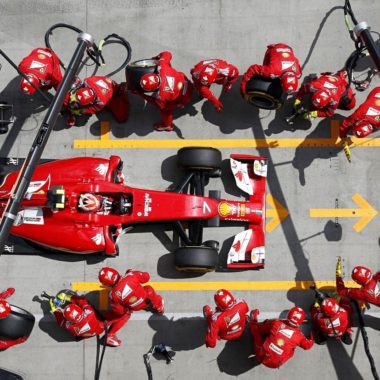In an increasingly competitive world, how do businesses keep driving themselves forward? Who do you track yourself against? Do you look at your historical performance, or do you monitor your performance against your competitors? I am sure you’ve heard about the practice of benchmarking – “a systematic search for best practices that leads to superior performance” (Lema and Price, 1995). In simple words, benchmarking is finding out who is the best at doing something and setting your targets against them.
When we look at sports, we see benchmarking everywhere. World records are constantly posted, techniques are mimicked, and consequently, the overall performance of athletes continues to improve.
In my opinion, one of the most exciting sports to watch in terms of benchmarking is Formula One (F1). Formula One (F1) is a perfect case of how benchmarking contributes to competitiveness. Every hundredth of a second counts in F1, and a disorganized pit stop can mean the difference between standing on the podium and a having a disappointing finish. Speaking of pit stops, can you guess the fastest pit stop ever recorded in F1 history? 1.92 seconds (Williams Team; 2016 season).
This number has been consistently decreasing over the years as pit crews set targets against their rivals and try to achieve quicker switchovers. F1 pit stops demonstrate the power of continuous improvement and the fact that you should never give up on your goal to reach perfection. It is also a picture-perfect case for using direct benchmarking against your competition.
Another type of benchmarking which can achieve remarkable results is called “indirect external benchmarking” and one of my favourite cases involves the Great Ormond Street Hospital for Children (GOSH) in England.
During the mid-1990s, GOSH faced high mortality rates in congenital heart disease surgeries. After in-depth inquiries into the matter, it was determined that the process of switching over and transferring a patient from the operating room to the intensive care unit (ICU) was the most critical high-risk factor leading to high mortality rates at GOSH.
This was a matter of public safety and it commanded the full attention of GOSH doctors, pushing them to think outside of the box and the medical field. What became evident is that the process they were hoping to correct was in many ways similar to what F1 pitstop teams were completing during races: a quick switchover.
At the time, the best pit stop crews belonged to Ferrari, and so an unlikely partnership began between Ferrari and GOSH. The Ferrari team had comprehensively mapped and documented every aspect of their process, clearly defined the role of every person and every movement was planned. Using its expertise in this area, Ferrari helped GOSH develop a 4-stage handover process for GOSH surgical processes.
The GOSH team also borrowed another aspect from F1 pit stop methodology to use in its surgical handover process: the lollipop man. This individual is charged with controlling and coordinating the movement of the pit crew and ensuring the system completes all the necessary tasks quickly and safely. At GOSH, the anesthetist became the lollipop man. In the newly designed process, the anesthetist was given the overall responsibility of leading the group and conducting various checks to ensure the safety of the patient until they were handed over to the intensivist at the ICU.
While it wasn’t possible for the team at GOSH to match practices in the exact same way the pit crews worked, they were able to learn from Ferrari and improve their processes. This unlikely case in benchmarking allowed for a reduction in handover errors and resulted in the improved safety of patients, and it all happened because the staff at GOSH were receptive to change and innovative ideas.
As a Business Process Improvement consultant, my favourite part of the job is my ability to engage organizations from different industries to achieve more. This provides me the opportunity to find commonalities between various processes and businesses. And in many of my projects I find myself thinking about completely different industries to identify best practices. I encourage you as well to think outside of the box more frequently.
Do you think your business could benefit from benchmarking? Contact us at [email protected] today to start a project!








